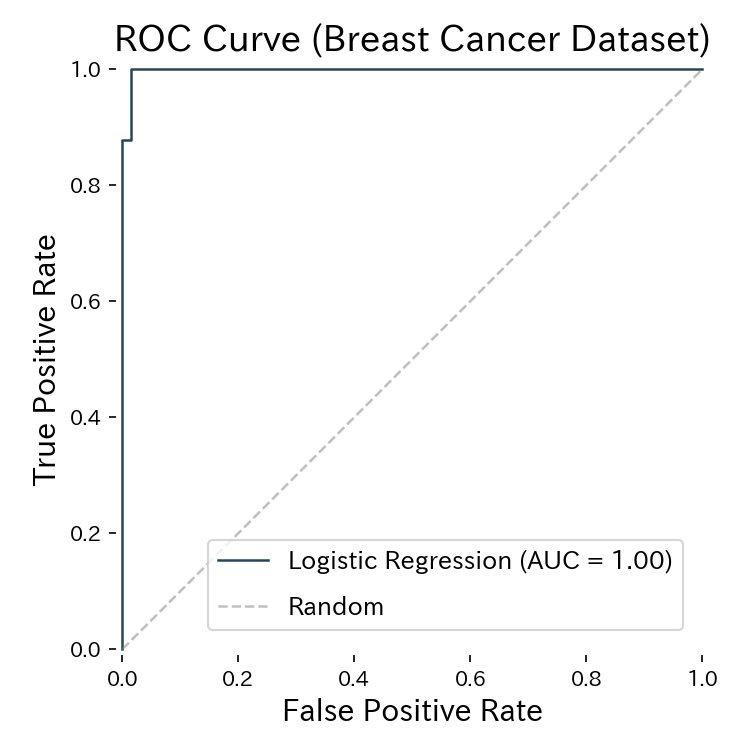まとめ
- ROC-AUC | A guide to threshold tuning and model comparisonの概要を押さえ、評価対象と読み取り方を整理します。
- Python 3.13 のコード例で算出・可視化し、手順と実務での確認ポイントを確認します。
- 図表や補助指標を組み合わせ、モデル比較や閾値調整に活かすヒントをまとめます。
1. What ROC and AUC represent #
The ROC curve traces False Positive Rate (FPR) on the x-axis and True Positive Rate (TPR) on the y-axis while sweeping the decision threshold from 0 to 1. The area under the curve (AUC) ranges between 0.5 (random guessing) and 1.0 (perfect separation).
- AUC ≈ 1.0 → excellent discrimination
- AUC ≈ 0.5 → indistinguishable from random
- AUC < 0.5 → the model may have flipped polarity; inverting the decision rule could improve performance
2. Implementation and plotting in Python 3.13 #
Check your interpreter and install the required packages:
python --version # e.g. Python 3.13.0
pip install scikit-learn matplotlib
The code below trains a logistic regression model on the breast cancer dataset, draws the ROC curve, and saves the figure to static/images/eval/classification/rocauc. It is compatible with generate_eval_assets.py so you can refresh assets automatically.
import matplotlib.pyplot as plt
from pathlib import Path
from sklearn.datasets import load_breast_cancer
from sklearn.linear_model import LogisticRegression
from sklearn.metrics import RocCurveDisplay, roc_auc_score
from sklearn.model_selection import train_test_split
from sklearn.pipeline import make_pipeline
from sklearn.preprocessing import StandardScaler
X, y = load_breast_cancer(return_X_y=True)
X_train, X_test, y_train, y_test = train_test_split(
X, y, test_size=0.3, random_state=42, stratify=y
)
pipeline = make_pipeline(
StandardScaler(),
LogisticRegression(max_iter=2000, solver="lbfgs"),
)
pipeline.fit(X_train, y_train)
proba = pipeline.predict_proba(X_test)[:, 1]
auc = roc_auc_score(y_test, proba)
print(f"ROC-AUC: {auc:.3f}")
fig, ax = plt.subplots(figsize=(5, 5))
RocCurveDisplay.from_predictions(
y_test,
proba,
name="Logistic Regression",
ax=ax,
)
ax.plot([0, 1], [0, 1], "--", color="grey", alpha=0.5, label="Random")
ax.set_xlabel("False Positive Rate")
ax.set_ylabel("True Positive Rate")
ax.set_title("ROC Curve (Breast Cancer Dataset)")
ax.legend(loc="lower right")
fig.tight_layout()
output_dir = Path("static/images/eval/classification/rocauc")
output_dir.mkdir(parents=True, exist_ok=True)
fig.savefig(output_dir / "roc_curve.png", dpi=150)
plt.close(fig)

The AUC measures the area below the ROC curve; higher values indicate better ranking ability.
3. Using the curve for threshold tuning #
- Recall-sensitive domains (healthcare, fraud): move along the curve to pick a higher TPR while keeping FPR acceptable.
- Balancing precision vs. recall: models with high AUC typically maintain good performance across a wider range of thresholds.
- Model comparison: AUC provides a single scalar to compare classifiers before picking an operating point. Combine ROC-AUC with precision–recall analysis to understand the cost of altering the decision threshold.
4. Operational checklist #
- Inspect class imbalance – even with AUC close to 0.5, a different threshold might still rescue important cases.
- Evaluate class-weight strategies – adjust class weights or sample weights and verify whether AUC improves.
- Share the plot – include the ROC curve in dashboards so teams can reason about trade-offs.
- Keep a Python 3.13 notebook – reproduce the calculation effortlessly whenever the model is retrained.
Summary #
- ROC-AUC captures how well a classifier ranks positives ahead of negatives across all thresholds.
- In Python 3.13, RocCurveDisplay and oc_auc_score make computation and plotting straightforward.
- Use the curve in tandem with precision–recall metrics to choose operating thresholds aligned with business goals.